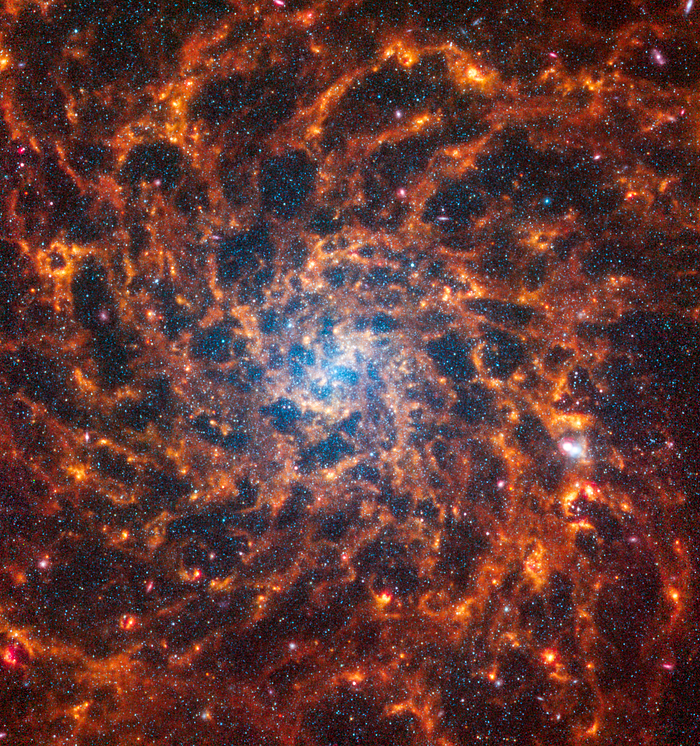
The latest Webb telescope images of 19 face-on spiral galaxies are stunning. They show dust lanes with dark holes or bubbles and lots of stars sprinkled all over. If we were to look at the Milky-Way disk from above, it would likely appear the same.
The evidence that we live in a punctured interstellar medium is evident around us. In particular, the Sun just entered such a hole, called the Local Bubble, over the past few million years. This Bubble is a cavity of rarefied hot gas surrounded by a dense shell of cold gas and dust with a radius of a few hundred light years. Most of the young stars near the Sun lie on the expanding shell of this Bubble. The latest data indicates that a burst of supernova explosions near the bubble center triggered its expansion about 14 million years ago.
In a recent paper that I wrote with Professor Merav Opher, we had used a state-of-the-art computer simulation to study the consequences of the Sun’s passage through the dense clouds in the shell of the Local Bubble about 2–3 million years ago. Our simulation showed that the protective heliosphere from the solar wind that surrounds us today, might have shrunk to a scale smaller than the Earth’s orbit around the Sun. As a result, the Earth was exposed during this passage through the Bubble’s dense shell to a very large flux of cosmic-rays and hydrogen atoms. This could have had drastic effects on Earth’s climate, as suggested by records of oxygen isotopes derived from foraminifera in the sea floor. It could have also potentially affected human evolution 2–3 million years ago, when Australopithecus afarensis (“Lucy”) went extinct and the Homo lineage emerged — leading to humans. In that case, the Local Bubble might have triggered the birth of humans. If so, it could have similarly given birth to other intelligent species on habitable planets around other stars in our cosmic neighborhood.
We know one thing for sure: on Earth, the seeds of the human species blossomed. By now, there are 8.1 billion humans, about a tenth of the number of stars in our Milky-Way galaxy. If real estate agencies ever trade interstellar properties, they could sell up to ten Milky-Way stars on average to each human on Earth.
The past century led to another phase transition on Earth. Today, there are 7.41 billion mobile phones in the hands of 92% of the number of people in the world. Combined, these mobile phones transmit about 10 Gigawatt of radio power at Gigahertz frequencies. The ultimate sensitivity of the planned Square Kilometer Array (SKA) will allow it to detect such a radio signal from a distance of up to 30 light years within 8 hours of integration. This is a convenient distance for us to have a conversation with extraterrestrials during a human lifespan, given that the roundtrip light travel time is 60 years.
If the extraterrestrial relay tower could amplify the alien signal enough, perhaps we could engage in a phone conversation. In such a case, all interstellar phones should be regarded as mobile since they move around the Milky-Way. We can ask the aliens whether their species also emerged over the past few million years, when their star passed through the dense shell of the Local Bubble. A common trigger might explain a nearly synchronous emergence of a local hub of recently-born intelligent species.
There are 540 stars catalogued within 30 light years. If we detect a phone signal from a planet circling any of these stars at the Earth-Sun separation, the orbital radius of the planet would span an angle of a tenth of an arcsecond at a distance of 30 light years. This motion could be resolved by Very Large Baseline Interferometry (VLBI) with a system of SKA-like radio telescopes around the Earth. Such an array could track the motion of a nearby transmitting planet even if the host is a dwarf star, like our nearest star Proxima Centauri, for which the habitable zone is about 25 times closer than the Earth-Sun separation.
The surface temperature of Proxima Centauri, 3000 degrees Kelvin, is roughly half that of the Sun. As a result, its characteristic radiation wavelength is twice that of visible light — in the infrared. “Survival of the fittest” suggests that aliens on a habitable planet around a dwarf star would likely have infrared eyes. If so, they might resemble the Mantis shrimp whose ultraviolet & infrared eyes look like two ping-pong balls attached by strings to its head. To find out if that is the case, we might ask them to share photos on their version of Instagram.
The variety of life forms could exceed our imagination if we ever venture beyond the Milky-Way into the bubbles of nearby galaxies imaged by the Webb telescope. We might be amazed by what is found farther away. But even if we were to sample all that lies inside our cosmic horizon, we might underestimate the diversity of lifeforms outside of the horizon.
Unfortunately, just as in Vegas, “what happens outside our cosmic horizon will stay outside our horizon.” We will never be able to see beyond the current horizon because the accelerated cosmic expansion will carry these distant regions away from us faster than the speed of light. Unfortunately, there is a fundamental limit to what even our most advanced telescopes can see.
ABOUT THE AUTHOR

Avi Loeb is the head of the Galileo Project, founding director of Harvard University’s — Black Hole Initiative, director of the Institute for Theory and Computation at the Harvard-Smithsonian Center for Astrophysics, and the former chair of the astronomy department at Harvard University (2011–2020). He chairs the advisory board for the Breakthrough Starshot project, and is a former member of the President’s Council of Advisors on Science and Technology and a former chair of the Board on Physics and Astronomy of the National Academies. He is the bestselling author of “Extraterrestrial: The First Sign of Intelligent Life Beyond Earth” and a co-author of the textbook “Life in the Cosmos”, both published in 2021. His new book, titled “Interstellar”, was published in August 2023.
